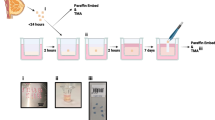Abstract
Bio-morphological understanding of the developing human mammary glands may clarify some aspects of breast pathology, including cancer. In particular, some epidemiological data suggests that during fetal growth an altered intrauterine hormonal status, especially a change in estrogen status, could predispose to carcinogenesis. In an attempt to achieve new information on early breast growth, a series of developing human breasts have been analyzed, namely: 4 fetal breasts (28–32 weeks of gestational age), 7 infant breasts (7 h to 2 years) and 1 puberal breast (12 years). In addition to the morphological features, we studied the immunohistochemical expression of some markers involved in morphogenesis, such as MIB-1 for cell proliferation, bcl-2 for apoptosis control, CD34 for vasculogenesis, estrogen (ER) and progesterone (PR) receptors for hormonal profile, and smooth-muscle actin for myoepithelial differentiation. The results were as follows: (a) lobules, absent between 28 weeks and 2 days, were well evident at 2 years of age and at puberty; (b) myoepithelial cells appeared from 28 weeks onward and persisted later with no modification in quantity and distribution; (c) epithelial cell proliferation was constantly low; (d) in all breasts inner epithelial cells showed diffuse bcl-2 positivity, while basal myoepithelial-like cells were generally negative; (e) all breasts were well vascularized with two different patterns: periductal vascularization (PDV) and interductal vascularization (IDV), IDV being always present, whereas PDV was found only in infant breasts; (f) ER and PR were almost absent in fetal and infant breasts, while their expression was high in the epithelial cells of the puberal breast; (g) stromal cells had no hormonal receptors and were heterogeneous for proliferation and bcl-2 expression. Interestingly, two fetal breasts showed high proliferation and high ER expression, respectively, in their epithelial compartment. This could be the expression of an altered hormonal environment in utero, representing a basis for possible subsequent cancer initiation.
Similar content being viewed by others
Author information
Authors and Affiliations
Additional information
Received: 14 July 1999 / Accepted: 3 November 1999
Rights and permissions
About this article
Cite this article
Naccarato, A., Viacava, P., Vignati, S. et al. Bio-morphological events in the development of the human female mammary gland from fetal age to puberty. Virchows Archiv 436, 431–438 (2000). https://doi.org/10.1007/s004280050470
Issue Date:
DOI: https://doi.org/10.1007/s004280050470




